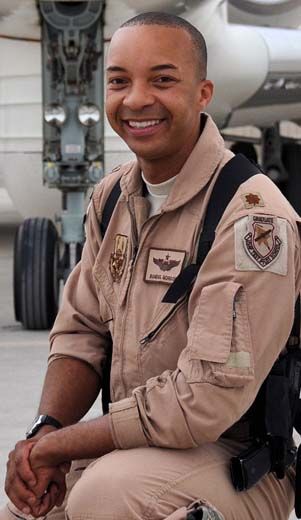Combat U.
Learning the art of the dogfight at Red Flag.
/https://tf-cmsv2-smithsonianmag-media.s3.amazonaws.com/filer/RedFlag-F15-flash.jpg)
I was on the far north side of a formation of eight F-15s. From my vantage point I could look south and see seven other Eagles, perfectly abreast, streaking supersonically heavenward, leaving white contrails in our wake. It’s called the “Eagle Claw”—from the ground it looks like an invisible bird of prey tearing the sky open with its talons. I was a young F-15 wingman in the opening moments of my first Red Flag exercise at Nevada’s Nellis Air Force Base.
The air-to-air mission is simple in theory but extremely difficult in execution. Our job was to clear the skies of enemy aircraft so the armada of bomber and strike aircraft behind us could do their job without worrying about a bad guy showing up at their six-o’clock position. Air-to-air combat is a game of high stakes three-dimensional chess against a living, breathing, thinking enemy. Small things like a bad radio call, misuse of avionics, or being out of formation can have a huge effect on the overall outcome of the battle.
My eight-ship formation of F-15s pushed downrange with our radars furiously beating up the sky looking for enemy aircraft. On the opposite side of the airspace, the F-16 aggressors—a professional force of highly skilled “Red Air” pilots well versed in enemy tactics—were waiting for us. This was their home turf, and their job was to show no mercy in confounding our targeting, punishing our mistakes, and “killing” as many of us as possible. At the start of the fight, everyone tried to communicate targeting and threat information simultaneously. It sounded like the floor of the New York Stock Exchange during a selling frenzy. Simulated missiles were flying between the opposing aerial fronts. Turn left, then hard right, then break left again. Throttles slammed forward to full afterburner, then rammed back to idle. My head was bouncing around like a tumbled gyro trying to keep track of my formation, where the threat was, and where the strike package (the aircraft we were protecting) was. It was like running a 400-meter dash while trying to take a Calculus test. I felt like the jet was flying me and I just was hanging on by my fingertips.
One of the aggressors managed to survive the initial onslaught of our attack and got close enough to visually attack my two-ship element. Luckily, my flight lead, a future U.S. Air Force Fighter Weapons School instructor and F-22 Raptor pilot, was cool under fire and managed to detect the threat in time to call for defensive maneuvers. In an instant, our two F-15s were in a two-versus-one, knockdown drag-out dogfight with a desert-camouflaged F-16 piloted by a lethal adversary. It never ceases to amaze me how even in the era of sleek supersonic jets, advanced air-to-air weapons, and high-tech avionics, dogfights are still at the heart of air-to-air combat.
We managed to win the engagement, but were now behind the timeline due to our impromptu dogfight. We raced ahead at over 500 miles per hour to catch up with the other six F-15s. The sound of the wind rushing over the canopy was deafening. We were deep in bad-guy land with threats all around. We managed to make it into position just in time to protect our bombers and strike aircraft as they attacked their targets, but we weren’t done yet. We still had to escort the strike package out of the danger area. Somehow my flight lead and I had survived and managed to get a couple of the bad guys in the process. I still have no idea how it happened.
During the debrief, we learned that even though our eight F-15s had done okay, we were far from perfect. We managed to eventually kill all of the Red Air, but not before some had made it around us and taken out some of the strike package. Our formation work and targeting were not pristine due to the tremendous pace and confusion of the fight. The strike package was disrupted and their attacks on the ground targets were not as successful as they could have been. The aggressors had done their job well by giving us a healthy dose of humility and teaching us many lessons. Red Flag is like a combat university where we learn from our mistakes and hone our tactics and teamwork in a hyper-realistic environment.
For the rest of the deployment, our performance improved with each air battle until, by the end of the exercise, we were dramatically more lethal at air-to-air combat. Even though the air threat increased in difficulty with each mission, we were able to defeat the Red Air with no losses on our side toward the end. I had passed Red Flag, one of the defining experiences of my time as an operational Eagle driver.
Major Randy J. Gordon is an experimental test pilot for the “Red Devils” of the 40th Flight Test Squadron at Eglin Air Force Base in Florida. He has flown combat missions over Iraq during Operation NORTHERN WATCH and over Afghanistan in support of Operation ENDURING FREEDOM.
